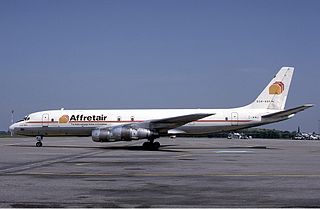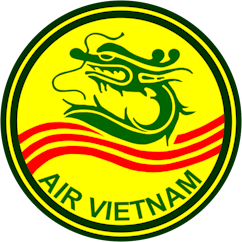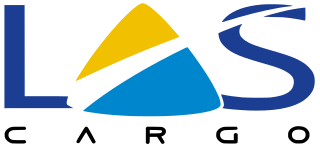
The Aviation Traders ATL-98 Carvair is a retired large transport aircraft powered by four radial engines. It was a Douglas DC-4-based air ferry conversion developed by Freddie Laker's Aviation Traders (Engineering) Limited (ATL), with a capacity generally of 22 passengers in a rear cabin, and five cars loaded in at the front.

The Douglas C-54 Skymaster is a four-engined transport aircraft used by the United States Army Air Forces in World War II and the Korean War. Like the Douglas C-47 Skytrain derived from the DC-3, the C-54 Skymaster was derived from a civilian airliner, the Douglas DC-4. Besides transport of cargo, the C-54 also carried presidents, prime ministers, and military staff. Dozens of variants of the C-54 were employed in a wide variety of non-combat roles such as air-sea rescue, scientific and military research, and missile tracking and recovery. During the Berlin Airlift it hauled coal and food supplies to West Berlin. After the Korean War it continued to be used for military and civilian uses by more than 30 countries. It was one of the first aircraft to carry the President of the United States, the first being President Franklin D. Roosevelt during World War II.

The Douglas DC-6 is a piston-powered airliner and cargo aircraft built by the Douglas Aircraft Company from 1946 to 1958. Originally intended as a military transport near the end of World War II, Douglas reworked it after the war to compete with the Lockheed Constellation in the long-range commercial transport market. Douglas built over 700, and many still fly in cargo, military, and wildfire control roles.

Loftleiðir HF, internationally known as Icelandic Airlines or Loftleiðir Icelandic, was a private Icelandic airline headquartered on the grounds of Reykjavík Airport in Reykjavík, which operated mostly trans-atlantic flights linking Europe and America, pioneering the low-cost flight business strategy on these routes.

Affretair was a cargo airline based in Zimbabwe.

The Douglas C-74 Globemaster was a United States heavy-lift cargo aircraft built by the Douglas Aircraft Company in Long Beach, California. The aircraft was developed after the Japanese attack on Pearl Harbor. The long distances across the Atlantic and, especially, Pacific oceans to combat areas indicated a need for a transoceanic heavy-lift military transport aircraft. Douglas Aircraft Company responded in 1942 with a giant four-engined design. Development and production modifications issues with the aircraft caused the first flight to be delayed until 5 September 1945, and production was limited to 14 aircraft when the production contract was cancelled following V-J Day.

Active from 1951 to 1975, Air Viet Nam was South Vietnam's first commercial air carrier, headquartered in District 1, Saigon. Established under a decree by Chief of State Bảo Đại, the airline flew over two million passengers, throughout the Vietnam War, and until its collapse due to the Fall of Saigon.

The Canadair CL-44 was a Canadian turboprop airliner and cargo aircraft based on the Bristol Britannia that was developed and produced by Canadair in the late 1950s and early 1960s. Although innovative, only a small number of the aircraft were produced for the Royal Canadian Air Force (RCAF), and for commercial operators worldwide.

American Overseas Airlines (AOA) was an airline that operated between the United States and Europe between 1945 and 1950. It was headquartered in Midtown Manhattan, New York City.

The Canadair North Star is a 1940s Canadian development, for Trans-Canada Air Lines (TCA), of the Douglas DC-4. Instead of radial piston engines used by the Douglas design, Canadair used Rolls-Royce Merlin V12 engines to achieve a higher cruising speed of 325 mph (523 km/h) compared with the 246 mph (396 km/h) of the standard DC-4. Requested by TCA in 1944, the prototype flew on 15 July 1946. The type was used by various airlines and by the Royal Canadian Air Force (RCAF). It proved to be reliable but noisy when in service through the 1950s and into the 1960s. Some examples continued to fly into the 1970s, converted to cargo aircraft.
Air Ferry Limited was a private, independent British airline operating charter, scheduled and all-cargo flights from 1963 to 1968.
Slick Airways was a cargo airline from the United States, that operated scheduled and chartered flights between 1946 and 1966. The airline was founded by Earl Slick, a Texas aviator and multimillionaire who along with his brother had inherited $25 million after their father's death in 1930.
Transmeridian Air Cargo was a British cargo airline that operated from 1962 until 1979 when it merged with IAS Cargo Airlines to form British Cargo Airlines.
Transocean Air Lines was an airline based in the United States that operated from 1946, when it was established as ONAT (Orvis Nelson Air Transport Company), until its bankruptcy in 1960. It was based in Oakland, California.

Líneas Aéreas Suramericanas S.A.S is a cargo airline based in Bogotá, Colombia. It operates scheduled and chartered cargo flights to Latin America and the Caribbean. Its main base is El Dorado International Airport, Bogotá.

The crash of Canadian Pacific Air Lines Flight 3505 occurred on 21 July 1951 when a Douglas DC-4 four-engined piston airliner registered CF-CPC of Canadian Pacific Air Lines disappeared on a scheduled flight for the United Nations from Vancouver, Canada, to Tokyo, Japan. Neither the aircraft nor the 31 passengers and six crew have been found. The incident marked the first aircraft loss during the Korean Airlift.

On April 8, 1954 Trans-Canada Air Lines Flight 9, a Canadair C-4 North Star four-engine commercial propliner on a domestic regular scheduled flight, collided in mid air with a Royal Canadian Air Force (RCAF) Harvard Mark II single engine military trainer on a cross-country navigation exercise over Moose Jaw, Saskatchewan.




















